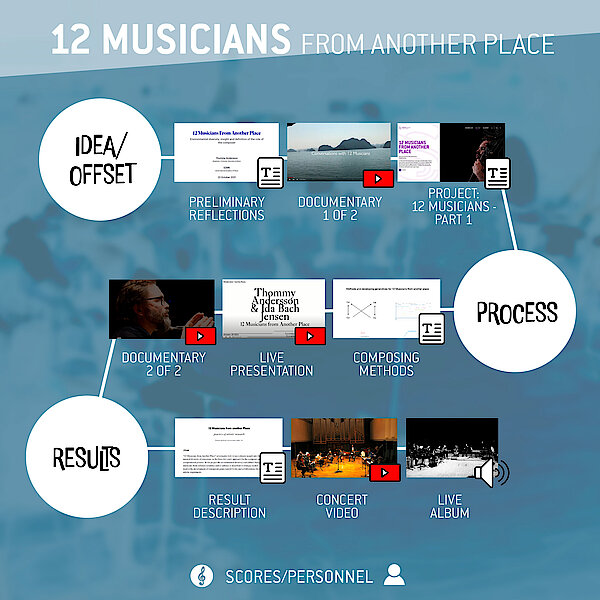12 Musicians from another Place, part 2
Thommy Andersson, KUV (2020)
"12 Musicians from Another Place" undersøger hvordan en dybere indsigt i musikeres kulturelle og musikalske diversitet kan gøres til grundlag for en ny indgangsvinkel for komponisten til den kompositoriske proces. Med afsæt i 12 musikeres miljømæssige diversitet og kulturelle baggrund formuleres og afprøves strategiske modeller for udviklingen af transparente genreneutra le værker og samarbejder gennem dialogiske kunstneriske eksperimenter.
OM projektet
12 Musicians from another Place
The ineffable space in a dialogic experiment for the composer
12 Musicians from Another Place" investigates how to use a deeper insight into the cultural and musical diversity of musicians, as the basis for a new approach for the composer and to his/her compositional process. In the project, the environmental diversity and cultural background of 12 musicians from different countries and/or cultures is described in strategic models, which in turn is used in the development of transparent genre-open works and collaborations through dialogic artistic experiments.
The conversations between the musicians gave way to wondering, understanding and questioning, which lead to further development of their creative output. In this research, the conversation is the main platform for investigating.
The project includes two overall phases influencing each other:
- The composition process where the composer, Thommy Andersson, based on insights and impressions collected through conversations, composes a musical platform for an ensemble consisting of the 12 participating musicians.
- A concert/workshop part where the ensemble meet, rehearses, discuss and performs the music.
Bringing performers from different environments, religions, economies and life patterns together offers both challenges and opportunities, but such diversity rarely stands in the way of music. The underlying assumption of the project is that focusing on the acquisition of insights into other artists’ musical backgrounds and social conditions provides great potential for developing new approaches to teaching in the field of music, and art creation in general.
As the role of the composer in this project is one of gathering people, the project also asks how a teaching based on this principle can be developed. By letting students take over the creative space from the compositions, we can probably gather more information from each other, and look into what the quality and diversity the group of students sustain.
By examining what a group of musicians can do together from a simple presentation by the composer, this project creates a sense of wonder about what we can do as a group when we’re pushing the limits, trying to let go of our expectations and experiences. But also what we individually can or should contribute with. As a facilitator, it is a transgressive act not to talk about music in the new surrounding of a project like this. Similar to the playing itself, it is fearful for most musicians in the project to talk about music as a participating musician in this setting. The desire to learn as a composer, gradually grows when the musicians themselves make all the decisions about whether this is of gain to their practice or not. Facilitating the meeting is the core and the composed material presented to the ensemble is custom-made in detail for every member.
Scores and instructions are here the way into the unknown space of facilitating musical output in this project. The composer must follow along, and must partly and totally let go of his/her experiences. The group had to gradually do the same and find a way together. Initially, there were the professional experiences taken for granted by the performers which prevented possible further development in the workshop.
By gradually letting go of this prevention, the ensemble tried hard to find a bigger dimension in their interplay, equally in music but also socially.
